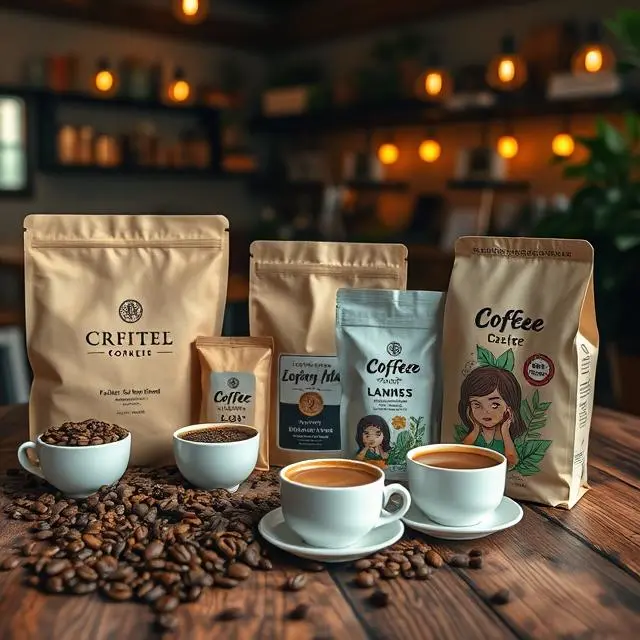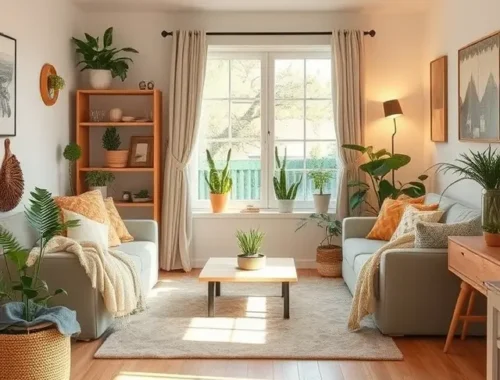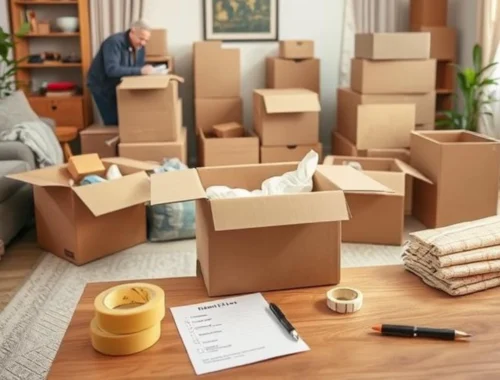
Custom Coffee Packaging
Table of Contents
ToggleCustom Coffee Packaging to Enhance Your Brand
In the highly competitive coffee industry, custom coffee packaging plays a crucial role in differentiating brands, attracting customers, and enhancing product appeal. Beyond just a protective layer, packaging serves as a marketing tool, storytelling medium, and brand ambassador. A well-designed coffee package not only preserves the freshness of the beans but also creates an emotional connection with consumers, making them more likely to choose your brand over others.
In this comprehensive guide, we will explore the importance of custom coffee packaging, its benefits, design elements, material choices, current trends, and how to select the right supplier. Whether you are a small coffee roaster or a large-scale brand, this guide will help you make informed decisions to boost your business.
Why Custom Coffee Packaging Matters?
1. Strengthening Brand Identity and Recognition
Branding is essential in the coffee industry. Your packaging should reflect your brand’s unique identity, vision, and values. A consistent color scheme, typography, logo placement, and messaging can help customers recognize your brand instantly.
For example, Starbucks has a distinctive green mermaid logo, and Lavazza uses deep blue and white branding. These elements create a strong visual identity that makes their products easily recognizable.
2. Capturing Consumer Attention
The average consumer spends only a few seconds deciding which coffee to buy. Eye-catching packaging with vibrant designs, innovative shapes, and bold typography can make your coffee stand out on crowded retail shelves.
A well-structured and engaging package design can create curiosity, compelling customers to try your product. Coffee brands that utilize bright colors, artistic illustrations, and modern minimalist designs often capture more consumer interest.
3. Communicating Your Brand Story
Consumers today appreciate authenticity and transparency. Your packaging should tell your brand’s journey, mission, and values. Whether you emphasize organic farming, fair-trade sourcing, sustainable practices, or artisanal roasting, incorporating these elements into your packaging design can build a deep emotional connection with consumers.
A simple way to achieve this is by adding handwritten-style fonts, earthy colors, and storytelling blurbs that describe the origin of the beans and the craftsmanship behind each cup of coffee.
4. Building Customer Loyalty
First-time buyers are more likely to return if they have a memorable experience with your packaging. Premium, sturdy, and uniquely designed coffee packaging can create a sense of luxury and exclusivity, making customers feel valued.
Additionally, reusable or resealable packaging encourages customers to keep your brand in their daily lives, further strengthening brand loyalty.
Benefits of Custom Coffee Packaging
1. Enhancing Product Shelf Appeal
Shelf appeal is one of the most crucial aspects of coffee packaging. Attractive, stylish, and aesthetically pleasing designs can persuade customers to pick your product over competitors.
Using modern trends like matte finishes, metallic foils, minimalist layouts, and embossed logos can significantly improve the perceived value of your coffee.
2. Ensuring Coffee Freshness and Longevity
Coffee is a delicate product that can lose its flavor and aroma if not stored properly. Custom coffee packaging with air-tight seals, one-way degassing valves, and resealable zippers helps maintain freshness by protecting coffee from moisture, air, and light exposure.
High-barrier packaging materials like foil-lined bags and kraft paper pouches can extend the shelf life of your coffee, ensuring customers enjoy a fresh and flavorful brew every time.
3. Supporting Sustainable and Eco-Friendly Initiatives
Consumers are increasingly becoming environmentally conscious. Sustainable packaging made from biodegradable, recyclable, or compostable materials can enhance your brand’s reputation.
Materials like PLA (Polylactic Acid), rice paper, and kraft paper offer eco-friendly alternatives that align with customer values while reducing your brand’s environmental footprint.
4. Customization for Different Product Lines
If you offer various coffee blends, custom packaging allows you to create distinct designs for each blend, roast, or origin. This helps customers easily differentiate between espresso blends, single-origin coffee, decaf options, and flavored varieties.
Utilizing color coding, unique symbols, or variant-based typography on your packaging can streamline the shopping experience and improve customer satisfaction.
5. Cost-Effective Marketing Strategy
Your packaging serves as a 24/7 advertisement for your brand. Unlike digital ads that require ongoing spending, once your packaging is designed, it continues promoting your brand without additional costs.
Including social media handles, QR codes, or website links on the packaging encourages customers to connect with your brand online, enhancing engagement and repeat purchases.
6. Protection and Freshness
The packaging plays a significant role in preserving the quality and freshness of your coffee beans. Custom coffee packaging, such as coffee bags for distributors, provides an airtight seal, keeping the coffee protected from light, moisture, and oxygen that can diminish flavor. Additionally, many coffee bags include one-way valves, which allow the beans to release gases without compromising the bag’s seal. This ensures that your customers receive the freshest coffee possible.
Key Elements of Custom Coffee Packaging
1. Selecting the Right Packaging Material
The choice of material impacts both the functionality and aesthetic appeal of coffee packaging. The most common materials include:
- Kraft Paper Bags – Biodegradable, eco-friendly, and gives a rustic, organic feel.
- Foil-Lined Bags – Excellent for preserving freshness and preventing oxidation.
- Plastic or PET Bags – Durable, flexible, but less sustainable.
- Glass Jars – Premium, reusable, and provides a luxury feel.
2. Crafting an Eye-Catching Design
Your coffee packaging should be both functional and visually appealing. Key design elements include:
- Color Psychology – Brown and green evoke natural and organic feelings, while black and gold symbolize luxury.
- Typography – Legible, stylish fonts that reflect your brand’s personality.
- Imagery and Graphics – Illustrations or minimalistic artwork that showcase coffee culture.
3. Functional Features for Customer Convenience
Adding user-friendly features can make your coffee packaging more appealing:
- Resealable Zippers – Maintain freshness for longer.
- One-Way Degassing Valves – Allow gases to escape while keeping oxygen out.
- Easy-Tear Notches – Enable quick and hassle-free opening.
4. Essential Branding Elements
Every coffee package should include:
- Brand Logo & Tagline
- Type of Coffee (Arabica, Robusta, Blend)
- Roast Level (Light, Medium, Dark)
- Origin and Sourcing Information
- Brewing Instructions & Serving Suggestions
- Sustainability and Ethical Sourcing Labels
Design Tips for Creating Eye-Catching Coffee Packaging
Designing custom coffee bags that stand out requires careful planning. Here are some design tips to help you create packaging that grabs attention and enhances your brand’s appeal:
- Use Bold, Clear Branding: Your coffee packaging should immediately communicate who you are and what makes your coffee special. Use bold colors and a clear logo to establish your brand identity. Consider incorporating unique elements like your coffee’s origin, flavor profile, or any special attributes that set it apart from competitors.
- Focus on Visual Appeal: The design of your coffee packaging should evoke the feeling or experience that your coffee offers. Whether it’s a premium, luxury product or a fun, everyday brew, your packaging design should reflect the tone of your brand. Think about adding illustrations, typography, and graphics that resonate with your target market.
- Choose the Right Packaging Material: Coffee bags come in a variety of materials, and choosing the right one is important for both practicality and aesthetics. For example stand up pouch bags are a popular choice for their ability to stand upright on shelves, providing excellent visibility. They also offer the flexibility of a resealable zipper to keep your coffee fresh after opening.
- Incorporate Functional Features: Consider adding functional features to your coffee packaging. One-way valves are essential for freshly roasted coffee beans, allowing for gas release without letting oxygen in. You can also opt for packaging with handles, spouts, or resealable options to make it more convenient for your customers.
- Consider Sustainability: Consumers are increasingly interested in sustainable products, and your packaging can reflect that. Consider using eco-friendly materials like compostable bags or recyclable pouches to appeal to this growing demographic.
Custom coffee packaging, such as custom printed mylar pouches, can provide the ideal solution to preserve your coffee’s freshness and enhance your branding efforts. Whether you’re looking to create a premium product line or simply need a durable, functional package, there are numerous options available to help you meet your needs.
Latest Trends in Custom Coffee Packaging (2024)
- Sustainable and Compostable Packaging – Increasing demand for eco-friendly solutions.
- Minimalist and Modern Designs – Clean, elegant packaging with less clutter.
- Personalized Packaging – Customizable elements for a personalized customer experience.
- Smart Packaging – QR codes and NFC technology to provide digital content.
- Matte and Textured Finishes – Enhancing tactile and visual appeal.
How to Choose the Right Coffee Packaging Supplier?
- Evaluate Material Quality – Ensure it maintains coffee freshness.
- Look for Customization Options – Printing, embossing, and special finishes.
- Consider Sustainability Credentials – Suppliers who use eco-friendly production.
- Compare Costs and Minimum Order Quantities (MOQs).
- Check Reviews and Industry Reputation.
Conclusion
Custom coffee packaging is a powerful tool that not only protects your product but also helps define your brand, attract customers, and build loyalty. By focusing on innovative designs, high-quality materials, and sustainable practices, coffee brands can stand out in a highly competitive market.
If you want your coffee to be the preferred choice among consumers, investing in high-quality, personalized coffee packaging is essential for success.
FAQs
What information should be on coffee packaging?
If you consume specialty coffee frequently, you should pay close attention to details like variety, origin, altitude, and flavor notes. On the other hand, you should provide beginners with useful information, including how to brew it properly.
How to package coffee for resale?
Coffee is most frequently packaged in foil-lined bags with a one-way valve that lets carbon dioxide escape from the coffee while keeping oxygen out of the bag. The greatest choice for maintaining the flavor, aroma, and freshness of coffee is this kind of bag.
What is sustainable coffee packaging?
PLA (polylactic acid)
PLA-based coffee packaging can break down in as little as 90 days in controlled composting settings, while traditional plastics take 1,000 years. Additionally, PLA coffee bags are ideal for digital printing techniques, which further lessens their carbon footprint.
What type of container is best for coffee?
The easiest way to keep coffee beans fresh is to keep them sealed in their original bag, but if the bag is opened, a canister works better. Sullivan advises keeping your coffee in an airtight or vacuum-sealed container and keeping it in a dark, dry place, such as a cabinet or pantry. Coffee also should not be stored in the refrigerator.
You May Also Like

How to Keep Your Home Comfortable on a Budget?
14 January 2025
How to organize when moving into a new home?
18 February 2025

